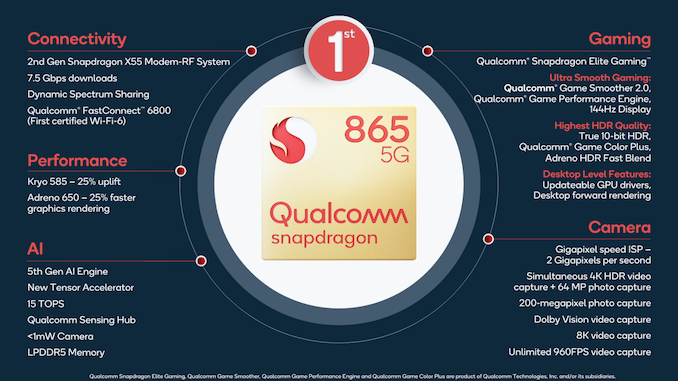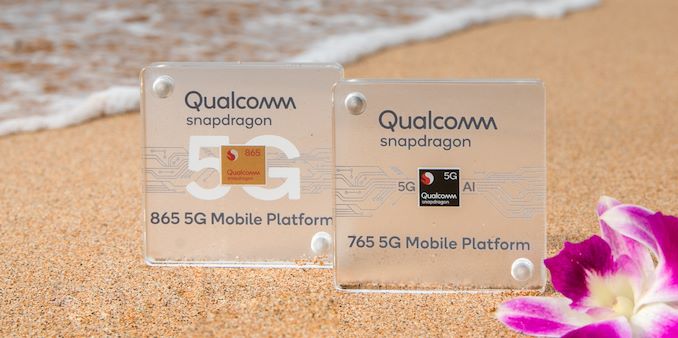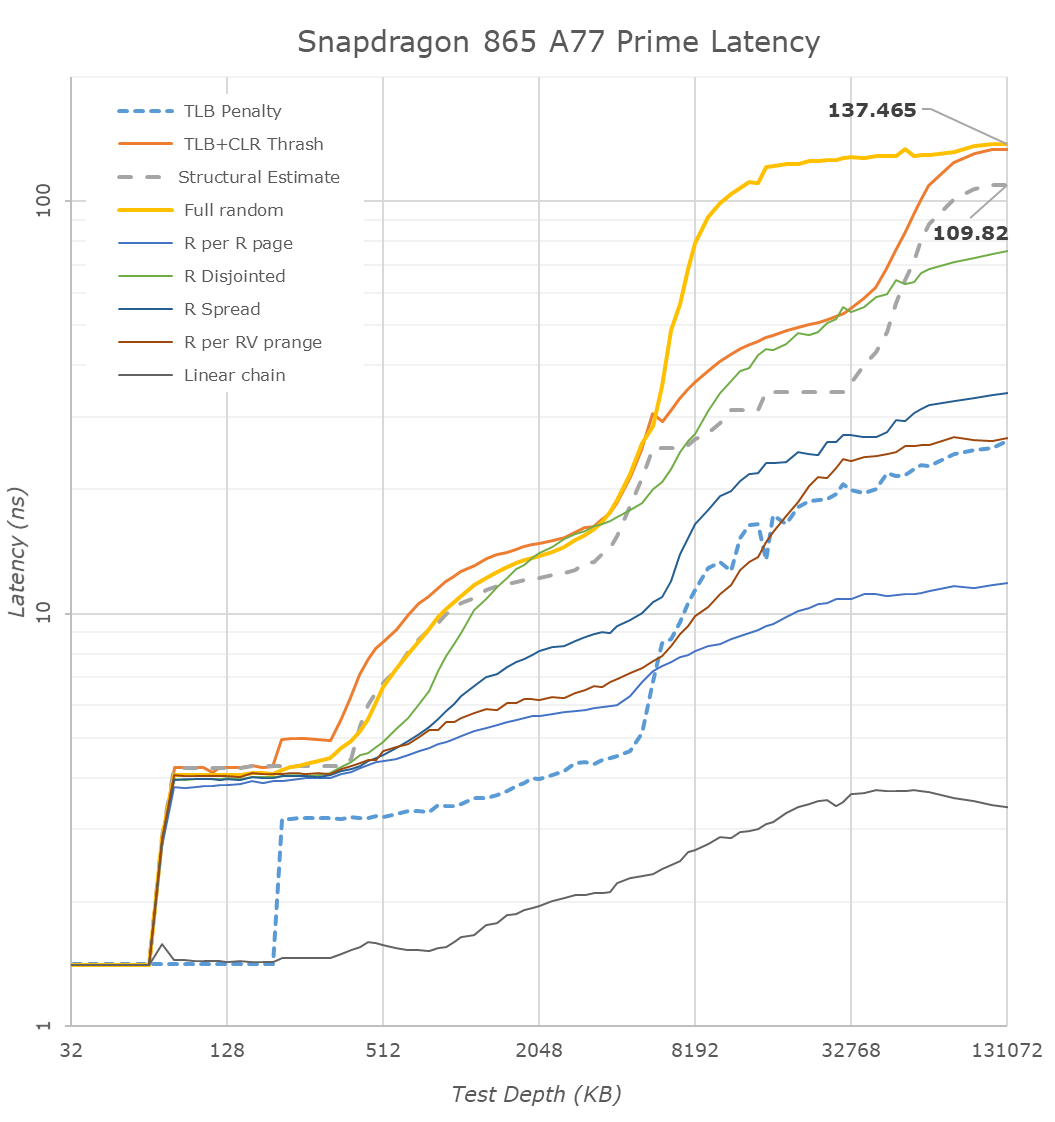The Snapdragon 865 Performance Preview: Setting the Stage for Flagship Android 2020
by Andrei Frumusanu on December 16, 2019 7:30 AM EST- Posted in
- Mobile
- Qualcomm
- Smartphones
- 5G
- Cortex A77
- Snapdragon 865

Earlier this month we had the pleasure to attend Qualcomm’s Maui launch event of the new Snapdragon 865 and 765 mobile platforms. The new chipsets promise to bring a lot of new upgrades in terms of performance and features, and undoubtedly will be the silicon upon which the vast majority of 2020 flagship devices will base their designs on. We’ve covered the new improvements and changes of the new chipset in our dedicated launch article, so be sure to read that piece if you’re not yet familiar with the Snapdragon 865.
As has seemingly become a tradition with Qualcomm, following the launch event we’ve been given the opportunity to have some hands-on time with the company’s reference devices, and had the chance to run the phones through our benchmark suite. The QRD865 is a reference phone made by Qualcomm and integrates the new flagship chip. The device offers insight into what we should be expecting from commercial devices in 2020, and today’s piece particularly focuses on the performance improvements of the new generation.
- Qualcomm Announces Snapdragon 865 and 765(G): 5G For All in 2020, All The Details
- Qualcomm Windows on Snapdragon: New 7c & 8c SoCs for sub-$800 Laptops
- Quick Bytes: Qualcomm’s Dynamic Spectrum Sharing Demo with 5G and 4G
- Quick Bytes: Qualcomm’s Prediction of 1.4 Billion 5G Smartphones by 2022
- Qualcomm Snapdragon Tech Summit Live Blog: Day One
- Qualcomm Snapdragon Tech Summit Live Blog Day Two: All About Mobile
- Qualcomm Snapdragon Tech Summit Day 3 Live Blog: ACPC and XR
A quick recap of the Snapdragon 865 if you haven’t read the more thorough examination of the changes:
| Qualcomm Snapdragon Flagship SoCs 2019-2020 | |||
| SoC |
Snapdragon 865 |
Snapdragon 855 | |
| CPU | 1x Cortex A77 @ 2.84GHz 1x512KB pL2 3x Cortex A77 @ 2.42GHz 3x256KB pL2 4x Cortex A55 @ 1.80GHz 4x128KB pL2 4MB sL3 @ ?MHz |
1x Kryo 485 Gold (A76 derivative) @ 2.84GHz 1x512KB pL2 3x Kryo 485 Gold (A76 derivative) @ 2.42GHz 3x256KB pL2 4x Kryo 485 Silver (A55 derivative) @ 1.80GHz 4x128KB pL2 2MB sL3 @ 1612MHz |
|
| GPU | Adreno 650 @ 587 MHz +25% perf +50% ALUs +50% pixel/clock +0% texels/clock |
Adreno 640 @ 585 MHz |
|
| DSP / NPU | Hexagon 698 15 TOPS AI (Total CPU+GPU+HVX+Tensor) |
Hexagon 690 7 TOPS AI (Total CPU+GPU+HVX+Tensor) |
|
| Memory Controller |
4x 16-bit CH @ 2133MHz LPDDR4X / 33.4GB/s or @ 2750MHz LPDDR5 / 44.0GB/s 3MB system level cache |
4x 16-bit CH @ 1866MHz LPDDR4X 29.9GB/s 3MB system level cache |
|
| ISP/Camera | Dual 14-bit Spectra 480 ISP 1x 200MP 64MP ZSL or 2x 25MP ZSL 4K video & 64MP burst capture |
Dual 14-bit Spectra 380 ISP 1x 192MP 1x 48MP ZSL or 2x 22MP ZSL |
|
| Encode/ Decode |
8K30 / 4K120 10-bit H.265 Dolby Vision, HDR10+, HDR10, HLG 720p960 infinite recording |
4K60 10-bit H.265 HDR10, HDR10+, HLG 720p480 |
|
| Integrated Modem | none (Paired with external X55 only) (LTE Category 24/22) DL = 2500 Mbps 7x20MHz CA, 1024-QAM UL = 316 Mbps 3x20MHz CA, 256-QAM (5G NR Sub-6 + mmWave) DL = 7000 Mbps UL = 3000 Mbps |
Snapdragon X24 LTE (Category 20) DL = 2000Mbps 7x20MHz CA, 256-QAM, 4x4 UL = 316Mbps 3x20MHz CA, 256-QAM |
|
| Mfc. Process | TSMC 7nm (N7P) |
TSMC 7nm (N7) |
|
The Snapdragon 865 is a successor to the Snapdragon 855 last year, and thus represents Qualcomm’s latest flagship chipset offering the newest IP and technologies. On the CPU side, Qualcomm has integrated Arm’s newest Cortex-A77 CPU cores, replacing the A76-based IP from last year. This year Qualcomm has decided against requesting any microarchitectural changes to the IP, so unlike the semi-custom Kryo 485 / A76-based CPUs which had some differing aspects to the design, the new A77 in the Snapdragon 865 represents the default IP configuration that Arm offers.
Clock frequencies and core cache configurations haven’t changed this year – there’s still a single “Prime” A77 CPU core with 512KB cache running at a higher 2.84GHz and three “Performance” or “Gold” cores with reduced 256KB caches at a lower 2.42GHz. The four little cores remain A55s, and also the same cache configuration as well as the 1.8GHz clock. The L3 cache of the CPU cluster has been doubled from 2 to 4MB. In general, Qualcomm’s advertised 25% performance uplift on the CPU side solely comes from the IPC increases of the new A77 cores.
The GPU this year features an updates Adreno 650 design which increases ALU and pixel rendering units by 50%. The end-result in terms of performance is a promised 25% upgrade – it’s likely that the company is running the new block at a lower frequency than what we’ve seen on the Snapdragon 855, although we won’t be able to confirm this until we have access to commercial devices early next year.
A big performance upgrade on the new chip is the quadrupling of the processing power of the new Tensor cores in the Hexagon 698. Qualcomm advertises 15 TOPS throughput for all computing blocks on the SoC and we estimate that the new Tensor cores roughly represent 10 TOPS out of that figure.
In general, the Snapdragon 865 promises to be a very versatile chip and comes with a lot of new improvements – particularly 5G connectivity and new camera capabilities are promised to be the key features of the new SoC. Today’s focus lies solely on the performance of the chip, so let’s move on to our first test results and analysis.
New Memory Controllers & LPDDR5: A Big Improvement
One of the larger changes in the SoC this generation was the integration of a new hybrid LPDDR5 and LPDDR4X memory controller. On the QRD865 device we’ve tested the chip was naturally equipped with the new LP5 standard. Qualcomm was actually downplaying the importance of LP5 itself: the new standard does bring higher memory speeds providing better bandwidth, however latency should be the same, and power efficiency benefits, while there, shouldn’t be overplayed. Nevertheless, Qualcomm did claim they focused more on improving their memory controllers, and this year we’re finally seeing the new chip address some of the weaknesses exhibited by the past two generations; memory latency.
We had criticised Qualcomm’s Snapdragon 845 and 855 for having quite bad memory latency – ever since the company had introduced their system level cache architecture to the designs, this aspect of the memory subsystem had seen some rather mediocre characteristics. There’s been a lot of arguments in regards to how much this actually affected performance, with Qualcomm themselves naturally downplaying the differences. Arm generally notes a 1% performance difference for each 5ns of latency to DRAM, if the differences are big, it can sum up to a noticeable difference.
Looking at the new Snapdragon 865, the first thing that pops up when comparing the two latency charts is the doubled L3 cache of the new chip. It’s to be noted that it does look that there’s still some sort of logical partitioning going on and 512KB of the cache may be dedicated to the little cores, as random-access latencies start going up at 1.5MB for the S855 and 3.5MB for the S865.
Further down in the deeper memory regions, we’re seeing some very big changes in latency. Qualcomm has been able to shave off around 35ns in the full random-access test, and we’re estimating that the structural latency of the chip now falls in at ~109ns – a 20ns improvements over its predecessor. While it’s a very good improvements in itself, it’s still a slightly behind the designs of HiSilicon, Apple and Samsung. So, while Qualcomm still is the last of the bunch in regards to its memory subsystem, it’s no longer trailing behind by such a large margin. Keep in mind the results of the Kirin 990 here as we go into more detailed analysis of memory-intensive workloads in SPEC on the next page.
Furthermore, what’s very interesting about Qualcomm’s results in the DRAM region is the behaviour of the TLB+CLR Trash test. This test is always hitting the same cache-line within a page across different, forcing a cache line replacement. The oddity here is that the Snapdragon 865 here behaves very differently to the 855, with the results showcasing a separate “step” in the results between 4MB and ~32MB. This result is more of an artefact of the test only hitting a single cache line per page rather than the chip actually having some sort of 32MB hidden cache. My theory is that Qualcomm has done some sort of optimisation to the cache-line replacement policy at the memory controller level, and instead the test hitting DRAM, it’s actually residing at on the SLC cache. It’s a very interesting result and so far, it’s the first and only chipset to exhibit such behaviour. If it’s indeed the SLC, the latency would fall in at around 25-35ns, with the non-uniform latency likely being a result of the four cache slices dedicated to the four memory controllers.
Overall, it looks like Qualcomm has made rather big changes to the memory subsystem this year, and we’re looking forward to see the impact on performance.













178 Comments
View All Comments
joms_us - Tuesday, December 17, 2019 - link
Ah poorman's attempt to hide the truth. I feel sorry for those buying a phone (even replacing a desktop) because they see it flying with colors in SPEC.Andrei Frumusanu - Tuesday, December 17, 2019 - link
You're just a blabbering idiot. You keep pulling things out your ass, nobody ever said A9 is faster than Ryzen or Skylake, I dare you find a quote or data that says that. The A13 was the first to *match* them.The test you quote isn't ST like the SPEC results, and it's not even a full CPU test as it has API components.
joms_us - Tuesday, December 17, 2019 - link
Ahh the irony... Let's see who is the blabbering !d!ot here.You reminded us on who the IPC gorila is...
https://twitter.com/andreif7/status/11569659188089...
There it shows A13 and even A9 stomping the latest and greatest Ryzen and Skylake processors
But then when you compare the A13 versus the Android SoC in various apps and websites, it is the complete opposite.
I respect you because you have an excellent knowledge in what you do but it comes down to the toilet drain once your critical thinking is subpar and you are shadowed with your ego that you think yours and only yours speak the truth. I would not hesitate to hire you as my design engineer really but you have to back your claims with facts. When you state one is the fastest (especially by huge margin), it has to reflect in any test that you throw at it.
I would rest my case if you can convince Lisa or Bob that their processors are mediocre compared to Apple's latest SoC LOL.
Andrei Frumusanu - Tuesday, December 17, 2019 - link
That tweet is about IPC of the microarchitectures, not absolute performance.You literally have absolutely not a single whim of understanding of what's going on here and keep making a complete utter fool of yourself repeating lies, all you see is a bar graph being bigger than the other and suddenly that's the your whole basis on the truth of the world.
The actual engineers and architects in the industry very well know where they lie in relation to what's Apple's doing; I don't need to convince anybody.
joms_us - Tuesday, December 17, 2019 - link
No, you just told the whole world, that the fastest chip on the planet is the Apple SoC. A chip with great IPC will give great performance result, right? Your graph is telling us, a 1Ghz A12x core is equivalent to a 2Ghz Ryzen core which is utter BS. When AMD or Intel announce that their next processor has 20% IPC improvement, it does show in any tool/benchmark or app you throw at it not the opposite.Your tests methodology/tools are completely flawed and outdated as they don't translate to real world results. They are great though if you are comparing two similar platforms.
Andrei Frumusanu - Tuesday, December 17, 2019 - link
> No, you just told the whole world, that the fastest chip on the planet is the Apple SoCI did not. High IPC doesn't just mean it's the fastest overall. AMD and Intel still have a slight lead in over performance.
> A chip with great IPC will give great performance result, right?
As long as the clock-rate also is high enough, yes.
> Your graph is telling us, a 1Ghz A12x core is equivalent to a 2Ghz Ryzen core
That's exactly correct. Apple current has the highest IPC microarchitecture in the industry by a large margin.
> which is utter BS.
The difference between you and me is that I actually have a plethora of data to back this up, actual instruction counter data from the performance counters, actual tests tests that show that Apple's µarch is in fact 50% wider than anything else out there.
You are doing absolutely nothing than spewing rubbish comments with absolutely zero understanding of the matter. You have absolutely nothing to back up your claims about flawed and outdated methodologies, while I have the actual companies who design these chips agreeing with the data I present.
arsjum - Wednesday, December 18, 2019 - link
Andrei,As a member of Anandtech staff, you should be better than this. This is not an XDA forum.
Come on.
LordConrad - Tuesday, December 17, 2019 - link
Now if Samsung could just increase the anemic L2 cache. I want 1MB per A7x core and 512KB per A5x core.yankeeDDL - Tuesday, December 17, 2019 - link
It is truly disappointing that Android HW needs to run on SoC with the performance of the iPhone 3-4 generations older.I really don't understand with all the demand there is, why nobody comes up with something at least within the range of Apple's SoC.
Wilco1 - Tuesday, December 17, 2019 - link
You mean 2 generations behind at most on SPEC. And while interesting technically, it remains debatable how much that actually matters in actual phone use (where having fast SSD, download speeds and a lot of memory can help more). As well as having ~20% better power efficiency of course.It would be relatively easy to quadruple L2 to 1MB, L3 to 8MB and system cache to 16MB and get ~20% performance gain on SPEC. The area would be much larger and hence the cost of the SoC which would add to the cost of phones. QC's competitors would be happy to increase their market share with far cheaper SoCs which are equally fast in real-world usage.